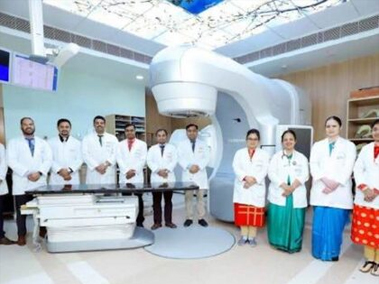What is Radiation Therapy and what does it do?
Radiation Therapy is use of high energy Ionization radiation (often X Rays ) to kill a cancer cell by damaging its DNA. Goal of Radiation Therapy (RT) is to use focused beams of radiation to kill cancer cell with as little risk as possible to normal cells. Radiation treatment, like surgery, is a local treatment. It affects the cancer cells only in a specific area of the body.
Timing of RT
RT can be used before surgery to shrink a tumor, called as neoadjuvant/pre operative RT (Pre op RT). It may be used after surgery to stop growth of cancer cells that may remain called as adjuvant RT (Post op RT). At times radiation is used alone with curative intent which is called as Radical RT. It can also be used at the time of surgery known as Intraoperative Radiation (IORT).
Types of RT
When the source of radiation is from a machine outside the body, it’s called as External Beam Radiation therapy (EBRT). When radioactive material is placed close to tumour or area harboring cancer cells it’s called as Brachytherapy.
What is EBRT?
EBRT is usually given during outpatient visits (OPD Treatment) to a hospital. In this, a machine (also called as Linear Accelerator/LA) directs the high energy rays at the tumor bearing area within body. Linear Accelerators have the capability of delivering RT by various techniques like IMRT (Intensity Modulated Radiation Therapy), IGRT (Image Guided Radiation Therapy), SRS (Stereotactic Radiation Therapy) and SBRT (Stereotactic Body Radiation Therapy).
What is IMRT?
Intensity-modulated radiation therapy (IMRT) refers to a technique of focusing radiation therapy at cancer bearing area using computer based optimization process to carefully create a gradient or a dose fall-off between the cancer/target tissues and the surrounding normal tissues. This fall of dose saves the surrounding normal organs effectively. Therefore, these techniques offer the prospect of increasing the cancer control probability while decreasing the side effects.
What is IGRT?
Image guided radiation therapy (IGRT) is classically defined as radiation therapy that is delivered only after verification of position of structures of interest by performing either an X-Ray or CT based image. The same are done by an imaging system mounted on the linear accelerator itself. IGRT technically includes IMRT and hence also called as IM- IGRT (Intensity-modulated Image guided radiation therapy)
What is SBRT?
Stereotactic body radiation therapy (SBRT) refers to use of principles of stereotaxy to identify and pin pointedly deliver precisely deliver intense doses of RT to only to cancer/tumour area. SBRT is essentially similar to Stereotactic Radiosurgery (SRS) brain except that term SBRT used when we are targeting areas outside brain. Since SBRT involves delivery of higher intensity of radiation doses in shorter time, it also known as SABR (Stereotactic Ablative RT). SBRT is generally done by combining IMRT and IGRT together. SBRT generally has fewer sitting /fractions of radiation as compared to conventional IMRT or IGRT.
Your Radiation Oncologist will discuss all these techniques and how they are relevant for your cancer and its treatment.
What is more important for successful radiation therapy- Machine or team behind machine?
Both machines and team behind machines are equally critical in successful delivery of RT.
While technology always opens the door, it is always a skillful doctors who can get inside it.


